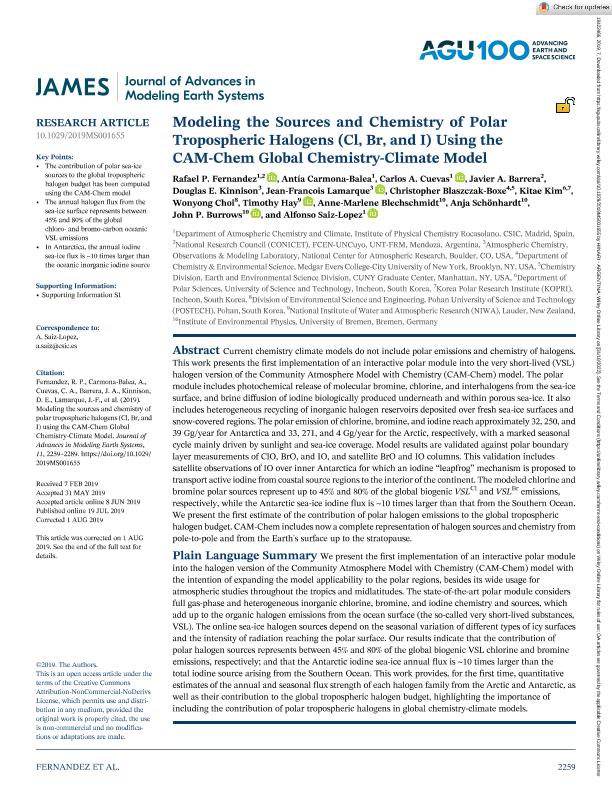Artículo
Modeling the Sources and Chemistry of Polar Tropospheric Halogens (Cl, Br, and I) Using the CAM-Chem Global Chemistry-Climate Model
Fernandez, Rafael Pedro ; Carmona Balea, Antía; Cuevas, Carlos Alberto; Barrera, Javier Alejandro
; Carmona Balea, Antía; Cuevas, Carlos Alberto; Barrera, Javier Alejandro ; Kinnison, Douglas E.; Lamarque, Jean Francois; Blaszczak Boxe, Christopher; Kim, Kitae; Choi, Wonyong; Hay, Timothy; Blechschmidt, Anne Marlene; Schönhardt, Anja; Burrows, John P.; Saiz López, Alfonso
; Kinnison, Douglas E.; Lamarque, Jean Francois; Blaszczak Boxe, Christopher; Kim, Kitae; Choi, Wonyong; Hay, Timothy; Blechschmidt, Anne Marlene; Schönhardt, Anja; Burrows, John P.; Saiz López, Alfonso
 ; Carmona Balea, Antía; Cuevas, Carlos Alberto; Barrera, Javier Alejandro
; Carmona Balea, Antía; Cuevas, Carlos Alberto; Barrera, Javier Alejandro ; Kinnison, Douglas E.; Lamarque, Jean Francois; Blaszczak Boxe, Christopher; Kim, Kitae; Choi, Wonyong; Hay, Timothy; Blechschmidt, Anne Marlene; Schönhardt, Anja; Burrows, John P.; Saiz López, Alfonso
; Kinnison, Douglas E.; Lamarque, Jean Francois; Blaszczak Boxe, Christopher; Kim, Kitae; Choi, Wonyong; Hay, Timothy; Blechschmidt, Anne Marlene; Schönhardt, Anja; Burrows, John P.; Saiz López, Alfonso
Fecha de publicación:
06/2019
Editorial:
American Geophysical Union
Revista:
Journal of Advances in Modeling Earth Systems
ISSN:
1942-2466
Idioma:
Inglés
Tipo de recurso:
Artículo publicado
Clasificación temática:
Resumen
Current chemistry climate models do not include polar emissions and chemistry of halogens. This work presents the first implementation of an interactive polar module into the very short-lived (VSL) halogen version of the Community Atmosphere Model with Chemistry (CAM-Chem) model. The polar module includes photochemical release of molecular bromine, chlorine, and interhalogens from the sea-ice surface, and brine diffusion of iodine biologically produced underneath and within porous sea-ice. It also includes heterogeneous recycling of inorganic halogen reservoirs deposited over fresh sea-ice surfaces and snow-covered regions. The polar emission of chlorine, bromine, and iodine reach approximately 32, 250, and 39 Gg/year for Antarctica and 33, 271, and 4 Gg/year for the Arctic, respectively, with a marked seasonal cycle mainly driven by sunlight and sea-ice coverage. Model results are validated against polar boundary layer measurements of ClO, BrO, and IO, and satellite BrO and IO columns. This validation includes satellite observations of IO over inner Antarctica for which an iodine “leapfrog” mechanism is proposed to transport active iodine from coastal source regions to the interior of the continent. The modeled chlorine and bromine polar sources represent up to 45% and 80% of the global biogenic VSLCl and VSLBr emissions, respectively, while the Antarctic sea-ice iodine flux is ~10 times larger than that from the Southern Ocean. We present the first estimate of the contribution of polar halogen emissions to the global tropospheric halogen budget. CAM-Chem includes now a complete representation of halogen sources and chemistry from pole-to-pole and from the Earth's surface up to the stratopause.
Archivos asociados
Licencia
Identificadores
Colecciones
Articulos(CCT - MENDOZA)
Articulos de CTRO.CIENTIFICO TECNOL.CONICET - MENDOZA
Articulos de CTRO.CIENTIFICO TECNOL.CONICET - MENDOZA
Citación
Fernandez, Rafael Pedro; Carmona Balea, Antía; Cuevas, Carlos Alberto; Barrera, Javier Alejandro; Kinnison, Douglas E.; et al.; Modeling the Sources and Chemistry of Polar Tropospheric Halogens (Cl, Br, and I) Using the CAM-Chem Global Chemistry-Climate Model; American Geophysical Union; Journal of Advances in Modeling Earth Systems; 11; 7; 6-2019; 2259-2289
Compartir
Altmétricas



